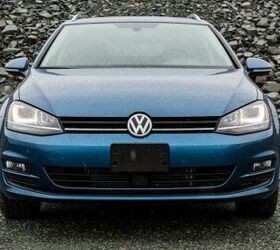The Volkswagen Golf SportWagen, particularly the 2015 model, has long been a vehicle that resonates with automotive enthusiasts who appreciate practicality and efficiency. Often lauded as the smarter choice over SUVs and even its sedan counterpart, the Jetta, the SportWagen offers a unique blend of Golf’s renowned driving dynamics with the added versatility of a wagon. Let’s delve into a detailed exploration of the 2015 Golf Sportwagen, examining its strengths, weaknesses, and overall appeal in the competitive wagon market.
Exterior Styling and Design
Replacing the Jetta wagon in Volkswagen’s US lineup, the 2015 Golf SportWagen distinguishes itself by aligning more closely with the Golf lineage. Built upon Volkswagen’s MQB modular platform, shared with the contemporary Mk7 Golf and Audi A3, this SportWagen benefits from modern engineering and design principles. Notably, despite being both longer and wider than its Jetta wagon predecessor – 1.1 inches longer and 0.7 inches wider – the Golf SportWagen manages to be approximately 134 pounds lighter, showcasing advancements in platform technology and material usage. The slightly lower roofline, by 1.1 inches, may also contribute to improved aerodynamics.
While the underlying platform represents a significant shift, the visual evolution from the previous Jetta wagon is more subtle. The front fascia of the 2015 Golf SportWagen is unmistakably Golf, maintaining a familiar and cohesive brand identity. The test model featured LED daytime running lights, enhancing visibility and adding a modern touch to the front lighting signature. Discreetly integrated within the bumper is the radar sensor for adaptive cruise control and other driver-assistance systems, a testament to Volkswagen’s refined approach to technology integration compared to some competitors.
Moving to the rear, the SportWagen adopts unique sheet metal and taillights that offer a more contemporary and appealing aesthetic compared to the previous Jetta wagon. The taillight design conveys a sense of sharpness and modernity, adding character to the practical wagon form. The side profile of the 2015 Golf SportWagen effectively embodies the long-roof design, with a relatively upright D-pillar and clean, flowing lines that prioritize functionality and visual harmony. The Silk Blue Metallic paint of the test vehicle adds a touch of vibrancy without being overtly ostentatious, while the wheel design might be considered slightly bolder than the car’s overall understated demeanor.
Interior Comfort and Practicality
Stepping inside the 2015 Golf SportWagen reveals an interior environment consistent with the broader Golf family – characterized by quality materials, thoughtful layout, and user-friendly controls. The design emphasizes functionality and ease of use, with straightforward dials and controls. However, the infotainment display in this model year is noted as being somewhat basic, lacking in advanced features and connectivity options that are now commonplace.
From a practical standpoint, the interior of the SportWagen proves to be easily maintainable. Cleaning and tidying the cabin is straightforward, with surfaces responding well to simple cleaning methods. The instrument panel is clear and legible, a welcome departure from distracting blue lighting accents found in some previous Volkswagen models. The driving position is noted as being comfortable and accommodating, even for taller drivers. While the seats are comfortable for everyday driving, they are not described as being exceptionally supportive or luxurious.
A standout feature of the 2015 Golf SportWagen, and indeed the Golf and Jetta models in general, is exceptional visibility. Volkswagen has prioritized outward visibility, ensuring a clear view of the surroundings without compromising passenger safety through excessively high beltlines. This is particularly beneficial in a wagon body style, where the extended cargo area can sometimes hinder rearward visibility. The expansive glass area contributes to a bright and airy cabin ambiance.
Infotainment and Technology Limitations
One of the primary criticisms leveled against the 2015 Volkswagen Golf SportWagen pertains to its infotainment system. In 2015, the technology interface was considered dated and lacking in essential modern features, particularly connectivity. A significant drawback was the absence of USB ports, limiting options for charging and connecting modern smartphones and media devices. The infotainment system itself was described as subpar, with clunky navigation and limited media input capabilities.
Furthermore, the Bluetooth pairing process for phones and media devices was considered cumbersome. Instead of utilizing the central touchscreen, drivers were required to navigate menus using steering wheel controls and the instrument panel display for Bluetooth pairing. This design was inconvenient, especially for passengers wanting to connect their devices, necessitating driver intervention. The review suggests that Volkswagen was expected to address these infotainment shortcomings in the subsequent model year (MY2016) with the introduction of the MIB II system, anticipated to include USB ports and smartphone integration platforms like Apple CarPlay and Android Auto.
Drivetrain and Performance: TDI vs. TSI
The 2015 Golf SportWagen TDI, equipped with a 2.0-liter turbocharged diesel engine, shares a characteristic trait with the diesel Jetta of the same era – noticeable hesitation from a standstill. The engine’s torque delivery at very low RPMs is not immediate, resulting in a slight delay in acceleration from a complete stop until the turbocharger spools up. While this initial lag can be disconcerting at first, drivers can adapt their driving style to compensate for it over time.
The six-speed DSG automatic transmission, also shared with the Jetta TDI, is praised for its crisp and quick gear changes. Aside from the initial diesel hesitation, the drivetrain operates smoothly and efficiently. Fuel economy is a strong suit of the TDI engine. Despite the added weight of the wagon body style, the Golf SportWagen TDI impressively achieved close to 40 mpg in observed testing, even with a significant portion of city driving.
However, the review expresses a preference for the gasoline-powered 1.8 TSI turbocharged engine option. Unless drivers prioritize maximizing fuel efficiency for very high mileage driving, or specifically desire diesel power, the 1.8 TSI is presented as a more engaging and enjoyable engine. The TSI engine is described as offering superior driveability and a more responsive feel, along with a lower initial purchase price. The availability of a manual transmission option with the TSI engine is also highlighted as a desirable feature for driving enthusiasts.
Driving Dynamics and Jetta Comparison
While the Golf is often positioned as a superior vehicle to the Jetta, this review suggests that the gap in driving experience between the 2015 Golf SportWagen TDI and the Jetta TDI is not as significant as commonly perceived, particularly for the average driver. The reviewer posits that in a blind test, most drivers would find both vehicles to be similarly competent and well-rounded.
Both the Golf SportWagen TDI and Jetta TDI exhibit similar driving characteristics. They share comparable suspension setups, providing a balance of comfort and handling. However, both models are noted as feeling somewhat heavy, likely due to the weight of the diesel engine. The brakes in both test vehicles required a firm pedal application to achieve strong stopping power.
The review ultimately steers towards a pragmatic conclusion: unless the wagon body style is a critical requirement, the Jetta represents a more financially sensible choice. The significant value proposition of the Jetta, especially considering attractive lease deals available at the time, makes it a compelling alternative to the Golf SportWagen. Leasing a Jetta is suggested as a strategic move, allowing consumers to benefit from a lower cost of ownership while waiting for Volkswagen to address the infotainment and technology shortcomings in future models. This approach provides immediate transportation needs while bridging the gap to potentially more advanced and feature-rich Volkswagen vehicles in the near future.
Conclusion: Practicality vs. Value
Ultimately, the 2015 Volkswagen Golf SportWagen TDI is acknowledged as a capable and practical vehicle, offering the sought-after combination of wagon versatility and diesel fuel efficiency. However, the review argues that the diesel Jetta, with its lower price point and comparable driving experience, presents a more compelling value proposition for many buyers. The decision hinges on individual needs and priorities – whether the specific advantages of the wagon body style outweigh the cost savings and overall value offered by the Jetta. For those prioritizing practicality and efficiency in a compact vehicle, both the 2015 Golf SportWagen and Jetta deserve consideration, with the Jetta emerging as a particularly attractive option for budget-conscious consumers.

